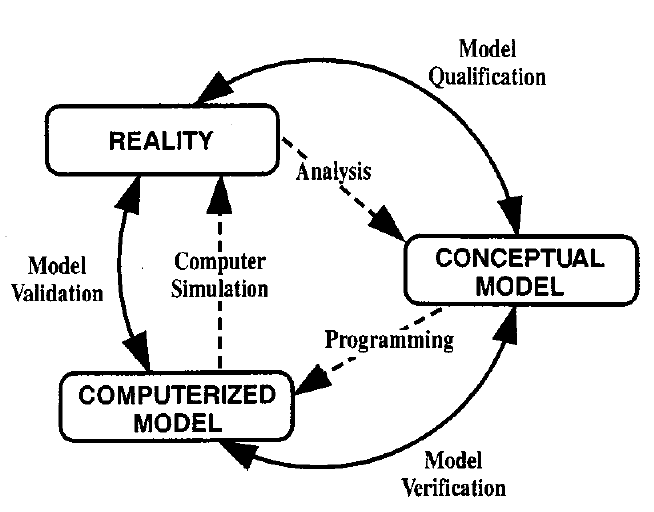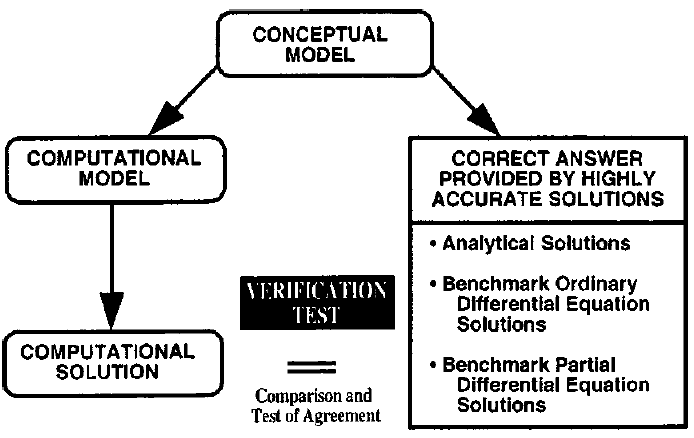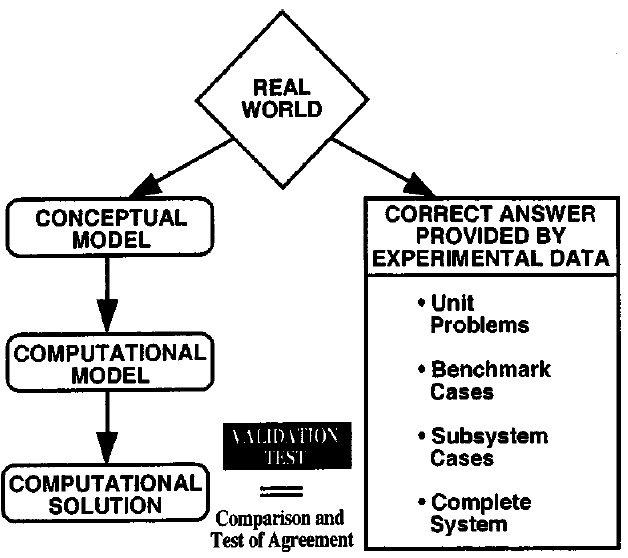NEPC Verification and Validation Philosophy¶
We use the standard definitions of verification and validation of scientific code as described in [oberkampf2004]
Verification: The process of determining that a model implementation accurately represents the developer’s conceptual description of the model and the solution to the model, including accuracy of the numerical solution.
Validation: The process of determining the degree to which a model is an accurate representation of the real world from the perspective of the intended uses of the model.

Figure 2. Phases of modeling and simulation and the role of V&V from [oberkampf2004].
Figure 2, a graphical representation from [schlesinger1979] and reproduced in [oberkampf2004], depicts the phases of modeling and simulation and the role of V&V. Two types of models are depicted in Figure 2: a conceptual model and a computerized model. In the context of NEPC, there are many conceptual models composed of mathematical equations and associated parameters that describe electron scattering processes used to estimate cross sections and reaction rates. The conceptual models also include all of the auxiliary equations used such as rovibronic wavefunctions for diatomic molecules. The computerized model is an operational computer program (i.e. code) that implements a conceptual model. The above figure clearly shows that the verification process evaluates the accuracy with which the computerized model implements the conceptual model and that validation clearly deals with the fidelity between the computerized model and experimental measurements (i.e. the real world).
Verification¶
The fundamental strategy of verification is to identify, quantify, and reduce errors in the computational model and its numerical solution. Figure 3 depicts the verification process of comparing the numerical solution from the code in question with various types of highly accurate solutions. The following detailed description of verification from [oberkampf2004]:
Given a numerical procedure that is stable, consistent, and robust, the five primary sources of errors in computational physics solutions are: insufficient spatial discretization, insufficient temporal discretization, insufficient iterative convergence, computer round-off, and computer programming. The emphasis in verification is on identifying and quantifying errors from these various sources, as well as on demonstrating the stability, consistency, and robustness of the numerical scheme. Stated differently, an analytical or formal error analysis is inadequate in the verification process; verification relies on demonstration and quantification of numerical accuracy.

Figure 3. Verification process from [oberkampf2004].
Validation¶
Also from [oberkampf2004]:
The fundamental strategy of validation involves identifying and quantifying the error and uncertainty in the conceptual and computational models, quantifying the numerical error in the computational solution, estimating the experimental uncertainty, and then comparing the computational results with the experimental data. This strategy does not assume that the experimental measurements are more accurate than the computational results. The strategy only asserts that experimental measurements are the most faithful reflections of reality for the purposes of validation. Validation requires that the estimation process for error and uncertainty must occur on both sides of the coin: mathematical physics and experiment.
This is especially true for validation of codes to estimate electron scattering cross sections. Often there are large errors in experimental measurements and the final state(s) of the atomic or molecular target gas may not be well known! Figure 4 depicts a typical validation process of comparing computational results with experimental data.

Figure 4. Validation process from [oberkampf2004].
- schlesinger1979
Schlesinger, S. “Terminology for model credibility.” Simulation. 32(3), 103–104.
- oberkampf2004(1,2,3,4,5,6,7)
Oberkampf, W. L., Trucano, T. G., and Hirsch, C. (December 21, 2004). “Verification, validation, and predictive capability in computational engineering and physics.” ASME. Appl. Mech. Rev. September 2004; 57(5): 345–384. https://doi.org/10.1115/1.1767847
